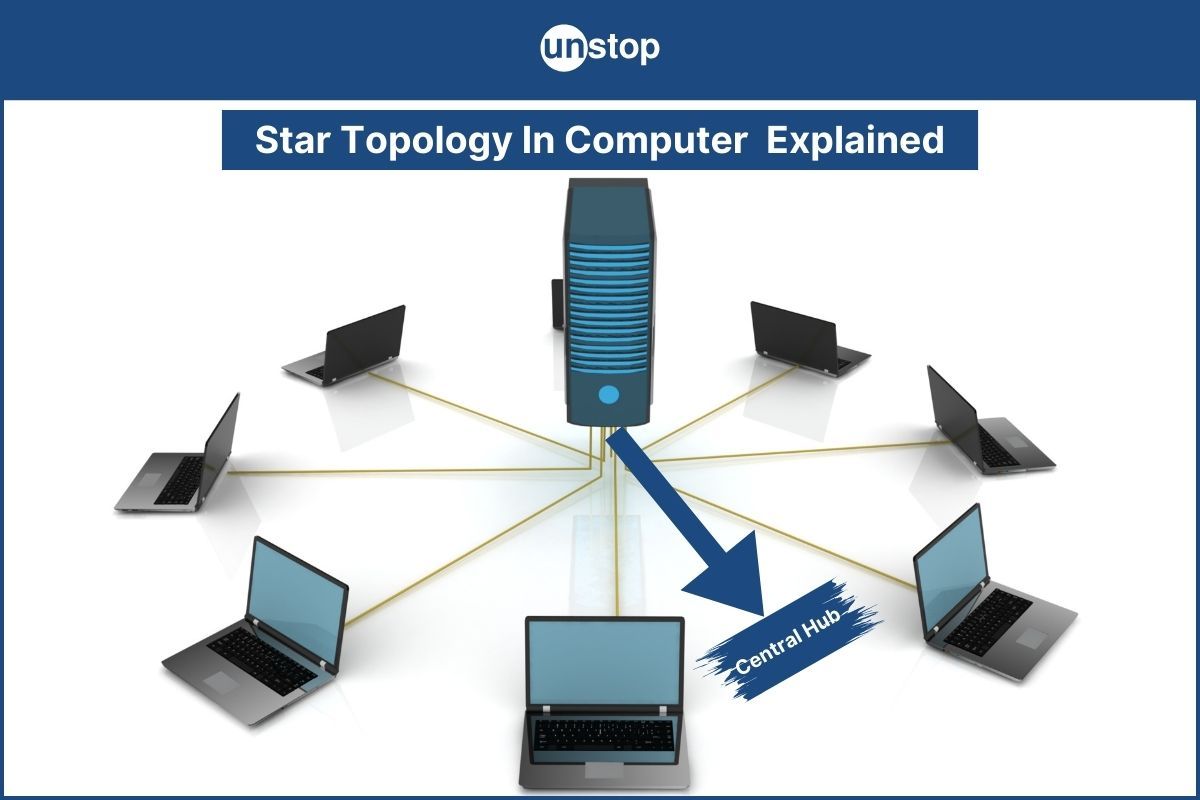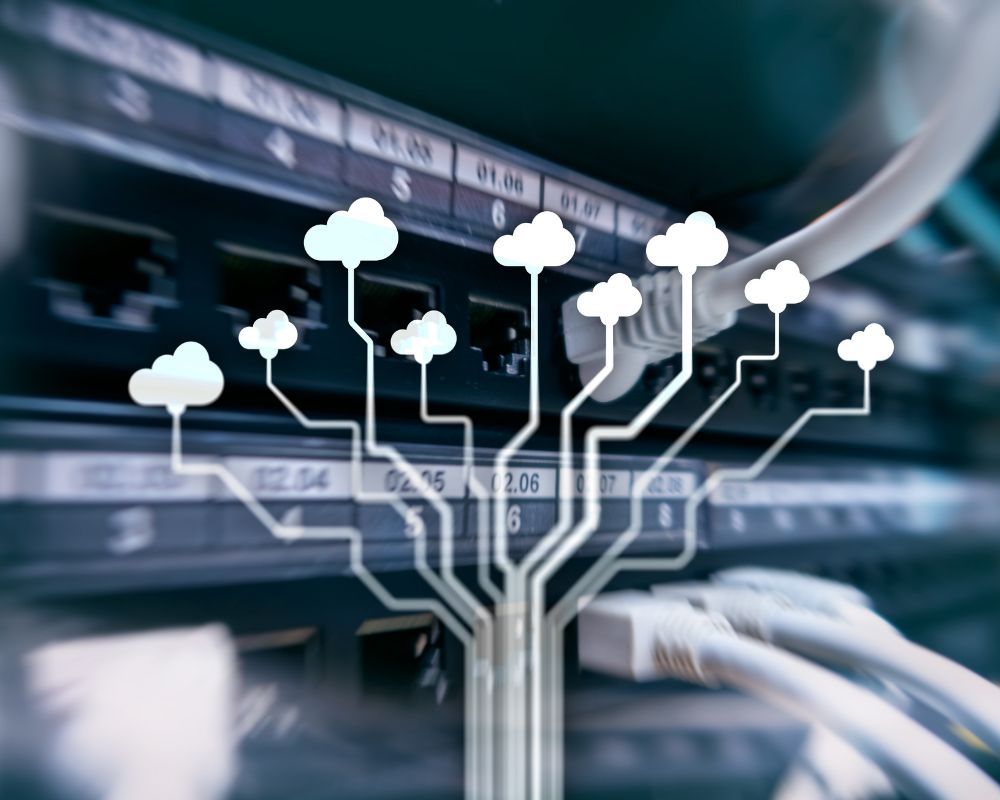- Understanding The Basics Of Star Topology
- Working Mechanism Of Star Topology
- Advantages & Disadvantages Of Star Topology
- Characteristics & Features Of Star Topology
- Hardware Equipment & Cable Types In Star Topology
- Fault Tolerance & Handling In Star Topology
- Impact Of Scalability & Mobility Of Star Topology
- Applications & Protocols Used In Star Topology
- Frequently Asked Questions (FAQs)
Star Topology In Computer Network - Everything You Must Know!

In computer networking, the star topology stands out as a pivotal configuration. This setup radiates from a central hub, connecting all devices directly. Each node communicates solely with this central point, enhancing efficiency and simplifying troubleshooting.
The structured layout ensures that if one connection fails, others remain unaffected—a key advantage in maintaining network integrity and performance.
Understanding The Basics Of Star Topology
Let us understand the basics of star topology in computer networking :
Central Hub
A star topology features a central hub connecting all devices in a network. This hub is the focal point, linking every device directly to it. The central hub can be a switch or a router, ensuring efficient communication among connected devices.

Each star topology device has a dedicated connection to the central hub. This setup prevents data collisions and ensures that information is transmitted directly to the intended recipient without passing through other devices.
Common Usage
Given its simplicity and ease of installation, star topology is commonly used in home networks. Adding more devices without disrupting the entire network's functionality allows easy troubleshooting and scalability.
Working Mechanism Of Star Topology
Let us now delve into the working mechanism of star topology in computer networking:

Data Transmission Process
In a star topology, data is sent through the central hub, which is a focal point for all connected devices. This setup allows for efficient management of data flow within the network.
The hub in a star network plays a crucial role in ensuring smooth data exchange between devices. The hub can effectively manage incoming and outgoing data traffic using its uplink ports.
This connection between devices and the central hub enhances communication speed and reliability.
Efficient Data Flow Management
One key advantage of working with a star topology is its ability to handle large amounts of data without compromising performance. The centralized nature of this network configuration simplifies troubleshooting and maintenance tasks.
Advantage & Disadvantage Of Star Topology
Let's also study some of the advantages and disadvantages of star topology in computer networking:
Easy Troubleshooting
In a star topology, identifying and fixing issues is straightforward since each device connects directly to the central hub. If one device encounters a problem, it does not affect the rest of the network's functionality. This ease of troubleshooting makes maintenance efficient.
Scalable For Network Expansion
One significant benefit of a star topology is its scalability. Adding new devices to the network involves connecting them to the central hub, allowing for seamless expansion as an organization grows. This flexibility in network growth is advantageous for businesses with evolving needs.
Dependency On Central Hub
A notable disadvantage of a star topology is its dependency on the central hub. If the central hub fails, all connected devices lose communication capabilities, leading to network downtime until the issue is resolved.
This reliance on a single point can be considered a weakness.
Characteristics & Features Of Star Topology
Let us also not forget to study the characteristics and features of star topology networking in computers:
High Reliability
A star topology network offers high reliability because if one device fails, it doesn't affect the entire network. Each device connects to a central hub, so issues are localized.
For example, in an office setup using a star network, if one computer encounters a problem, other computers can still function without disruption.
In a star network topology, the central connection point often called the central hub or server, is crucial in maintaining communication between devices.
This central node efficiently manages data flow among connected nodes by sending information directly from the source to the destination address.
Supports Various Types Of Devices
One of the key features of star topology is its flexibility in supporting various types of devices, such as computers, printers, scanners, and more. The central core acts as a mediator for these devices to communicate effectively within the network infrastructure.
This versatility makes it suitable for different environments like homes or offices where multiple services need connectivity.
Hardware Equipment & Cable Types In Star Topology
Let us study the hardware equipment and cable types in star topology:
Twisted Pair Cables
Star networks utilize twisted pair cables to connect devices to a central switch or hub. These cables are made of pairs of copper wires twisted together, reducing signal interference.
They are commonly used for Ethernet connections in star topologies. Twisted pair cables enable seamless communication signals between devices within a star network.
Central Switch Or Hub
A central device, such as a switch or hub, is vital in star topologies. This device acts as the focal point where all connected devices converge.
For instance, if a new device needs to be added, it can easily connect to the central switch or hub without disrupting existing connections. This arrangement allows for straightforward management and troubleshooting of individual connections within the network.
Fault Tolerance & Handling In Star Topology
Let us study how the fault tolerance and handling works in star topology:
Isolates Issues
A star topology isolates issues to individual devices, meaning if one device encounters a problem, it doesn't affect the entire network. For example, if a computer in a star network fails, only that specific device's connection is disrupted.
Each device connects directly to a central hub or switch in this setup. If these connections fail, other devices remain unaffected and can operate normally. This isolation ensures that troubleshooting and resolving issues are more straightforward than other network topologies.
Continues Functioning
One significant advantage of star topology is its ability to continue functioning even if one device fails. Since each device operates independently from others in the network, the failure of one node does not bring down the entire system.
For instance, if a printer connected to the central hub stops working in a star network office setup, all other computers can communicate without disruption.
This fault tolerance feature significantly reduces downtime because failures are contained within individual components rather than affecting the whole system simultaneously.
Impact Of Scalability & Mobility Of Star Topology
Let us study the impact of scalability and mobility of star topology:
Easily Scalable
Star topology networks are easily scalable by adding more devices, making them ideal for expanding systems without significant disruptions. Maintaining network performance while scaling up is a significant advantage of star topologies.
For example, if a business adds more employees who require network access, additional devices can be seamlessly integrated into the existing star network.
Impact Of Mobility
In star networks, mobility has minimal impact on data transfer efficiency. Mobile devices moving within the range of their designated access point do not disrupt connectivity for other users in the network.
This makes star topologies excellent choices for environments where mobile devices are prevalent, such as offices with multiple employees using laptops or smartphones.
Applications & Protocols Used In Star Topology
Let us study the applications and protocols used in star topology:
LAN Setups
Star topology is commonly used in LAN (Local Area Network) setups due to its efficiency and simplicity. It allows multiple devices to connect through a central hub or switch, making it ideal for small to medium-sized networks.
This network configuration supports protocols like Ethernet and Wi-Fi, enabling seamless communication between devices.
For example, Ethernet efficiently uses data packets to transmit information across the network.
Data Packet Transmission
In a star topology network, when a device sends a data packet, it travels directly to the central hub before being forwarded to the intended recipient. This direct communication pathway reduces data collisions and ensures efficient transmission within the network.

This setup works well when every device needs fair access to resources without any issues. By using Wi-Fi or Ethernet protocols, organizations can create dependable networks that meet their needs.
Conclusion
Star topology has emerged as a robust networking solution offering enhanced fault tolerance, scalability, and ease of maintenance in computer networking. Its centralized structure and efficient data transmission make it a preferred choice for various industry applications.
As organizations strive for reliable and flexible network setups, the star topology is a viable option that caters to modern connectivity needs effectively.
Frequently Asked Questions (FAQs)
1. What is the basic concept of a star network topology?
A star network topology consists of a central node that serves as a hub connecting individual nodes. All data transmission passes through this central hub, enabling efficient communication within the network.
2. How does fault tolerance work in a star network setup?
In a star network, if one node fails or encounters an issue, only that specific connection is affected while other nodes remain operational. This isolation ensures that the overall functionality of the network is maintained despite individual failures.
3. What are some common advantages and disadvantages of using a star topology?
Advantages include easy troubleshooting due to centralized management and high reliability. However, potential drawbacks may include higher costs associated with setting up and maintaining the central hub.
4. Which hardware equipment and cable types are typically used in star networks?
Commonly used hardware includes switches for wired networks or access points for wireless setups. As for cables, twisted-pair Ethernet cables are frequently employed to connect devices to the central hub in star topologies.
5. How does scalability play out in relation to mobility within star networks?
Star networks offer good scalability options by allowing additional nodes to be easily integrated into the existing structure. Mobility can impact performance depending on how well the network infrastructure supports seamless transitions between different locations.
Suggested reads:
Instinctively, I fall for nature, music, humor, reading, writing, listening, traveling, observing, learning, unlearning, friendship, exercise, etc., all these from the cradle to the grave- that's ME! It's my irrefutable belief in the uniqueness of all. I'll vehemently defend your right to be your best while I expect the same from you!
Login to continue reading
And access exclusive content, personalized recommendations, and career-boosting opportunities.
Subscribe
to our newsletter
















Comments
Add comment